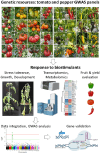Genomics control of biostimulant-induced stress tolerance and crop yield enhancement
- PMID: 40714810
- PMCID: PMC12308268
- DOI: 10.1111/tpj.70382
Genomics control of biostimulant-induced stress tolerance and crop yield enhancement
Abstract
Biostimulants are changing modern agriculture, as they have the potential to secure healthy and sustainable food production while preserving the environment. They have two main biological effects: growth promotion and stress protection. Both effects can lead to enhancement of the yield and improvement of the marketable grade of the produce in crops, without compromising crop quality. Their use increased exponentially in the past decade, as they are highly efficient, ecologically friendly (non-toxic, biodegradable), and applicable to all major crops. While exponential data on the physiological mechanisms of stress protection is accumulating in recent years, the information as to how biostimulants act at the molecular level is still rather limited. Here we review the growing evidence of the biostimulants role in stress protection and yield enhancement of crops, as well as the recent transcriptomic and metabolomic data, which indicate biostimulants' molecular mode of action. In particular, we outline the role of genes encoding signaling components, plant hormones (abscisic acid, brassinosteroids, and ethylene), genes encoding transcription factors from ERF, WRKY, NAC, and MYB families, and genes related to growth, photosynthesis, and stress response. Finally, we describe strategies to study the genetic and genomics control of biostimulants mode of action, with foci on stress tolerance and yield enhancement. In Arabidopsis, established systems for biostimulants-induced protection against drought and oxidative stress will allow both forward and reverse genetics approaches to identify key genes from the biostimulants network. Mutations in such genes compromise the stress-protective effect of biostimulants. In major crops such as pepper and tomato, large Genome Wide Association Studies (GWAS) panels can be utilized to study crops responses to biostimulants in terms of drought tolerance, fruit qualities, and yield in order to pinpoint genes controlling biostimulants-induced stress protection and yield enhancement. The combination of these approaches allows identification and verification of important genes involved in the pathways of biostimulant-induced stress protection and yield enhancement, as well as deciphering parts of the intricate biostimulant-signaling network.
Keywords: Arabidopsis; abiotic stress; biostimulants; drought; oxidative stress; tomato.
© 2025 The Author(s). The Plant Journal published by Society for Experimental Biology and John Wiley & Sons Ltd.
Conflict of interest statement
The author declares no conflict of interest.
Figures


Similar articles
-
Short-Term Memory Impairment.2024 Jun 8. In: StatPearls [Internet]. Treasure Island (FL): StatPearls Publishing; 2025 Jan–. 2024 Jun 8. In: StatPearls [Internet]. Treasure Island (FL): StatPearls Publishing; 2025 Jan–. PMID: 31424720 Free Books & Documents.
-
Genome-wide and transcriptome analysis of PdWRKY transcription factors in date palm (Phoenix dactylifera) revealing insights into heat and drought stress tolerance.BMC Genomics. 2025 Jul 1;26(1):589. doi: 10.1186/s12864-025-11715-6. BMC Genomics. 2025. PMID: 40597593 Free PMC article.
-
From Hormones to Harvests: A Pathway to Strengthening Plant Resilience for Achieving Sustainable Development Goals.Plants (Basel). 2025 Jul 27;14(15):2322. doi: 10.3390/plants14152322. Plants (Basel). 2025. PMID: 40805671 Free PMC article. Review.
-
Sexual Harassment and Prevention Training.2024 Mar 29. In: StatPearls [Internet]. Treasure Island (FL): StatPearls Publishing; 2025 Jan–. 2024 Mar 29. In: StatPearls [Internet]. Treasure Island (FL): StatPearls Publishing; 2025 Jan–. PMID: 36508513 Free Books & Documents.
-
The Black Book of Psychotropic Dosing and Monitoring.Psychopharmacol Bull. 2024 Jul 8;54(3):8-59. Psychopharmacol Bull. 2024. PMID: 38993656 Free PMC article. Review.
References
-
- Alam, M.Z. , Braun, G. , Norrie, J. & Hodges, D.M. (2013) Effect of Ascophyllum extract application on plant growth, fruit yield and soil microbial communities of strawberry. Canadian Journal of Plant Science, 93, 23–36.
Publication types
MeSH terms
Substances
Grants and funding
LinkOut - more resources
Full Text Sources
Miscellaneous

